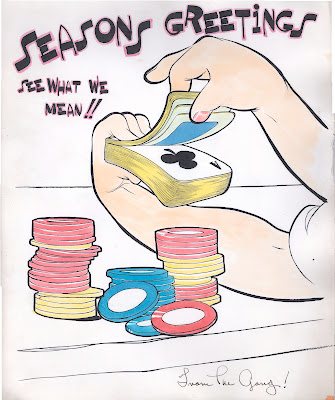 |
| Small drawing from border of 1930-31 FS staff photo Collection: V. Mahoney |
Of course there were gags galore on screen. It’s said that Dave Fleischer, who would oversee Fleischer Studios film production, wanted a gag in EVERY scene. According to animator Shamus Culhane: “Dave was a gagman with a flamboyant disregard for story structure and character motivation. His motto was a gag in every foot, and he would cram one into a scene regardless of the fact that it had very little or no connection with the story line…”
Off screen—nuttiness also invaded the work day!
 |
| Card by Fleischer animator Rudy Zamora Collection: V. Mahoney
Whether in New York or Florida, Christmas was a big event—for all, no matter what religion you were! Staff made Christmas cards they exchanged with each other. These cards were usually handmade- they might feature someone’s family, or characters from the studio. They might be a bit nutty or even off-color. But the highlight of the year was the party Max and Dave would give for the whole staff, usually in a large restaurant. As the staff grew- the party got bigger since by 1939 there were over 700 employees. These parties were usually wild bashes that included Santa, gag gifts, vaudeville acts by staff, plus the usual eating and drinking (for a full description of one of these wild parties and some actual film footage go to Fleischer Studios Christmas!).
The Christmas card above was to Seymour, from the studio group that hung out together and called themselves 'the gang.'
Gambling was a big activity for all….my mother said that when she worked at the studio (1929-31) no one went out for lunch – they played poker instead! Going to the race-track together was common—especially after the studio moved to Florida where there were dog races as well as horse races. In the New York studio someone even had a direct wire to the race-track in his office where staffers would routinely gather to check winners and losers.
They were such big betters that when the studio moved from New York to Florida their bookie moved with them! Max’s wife, Essie, was said to have had a direct wire to her bookie installed in a palm tree on their Florida property…. and Max, although greatly disturbed by the betting that went on during office hours, held a patent on a betting ‘wheel’ (above) he devised for the dog races. Below, Seymour in the middle, at the races.
Animator Shamus Culhane notes that (in the NY Fleischer days) a brownstone rooming house on 44th St. was completely taken over by Fleischer animators and became the site of the weekly gathering of card playing, drinking, and activity with ladies from the local bordello, who among other things, liked to play bridge. (Of course there were some staffers who led more conventional
Personal events—whether surgery or a wedding— usually
warranted a hand made card… below, part of a get well card for Max drawn by 'Doc' Crandall.
And milestones in the business of the studio were fodder for
cartoons in their in-house publications…. Their first feature film "Gulliver's Travels" was produced in an incredibly short time frame, and in the midst of the studio move from New York to Florida... their jokes below speak to the insanity of that time... (the top one by Willard Bowsky, the bottom one by Bob Little).
Here’s one more from the the April 1935 copy of their in-house Fleischer Animated News…. about Fleischer and ‘Bisney’ merging. This includes an interesting prediction, likely a far-fetched joke at the time, about their move to Florida... since it was May 1938 before Max and Paramount signed a contract to finance that new Florida building and move!
Seems like they knew how to have fun both on and off screen! If you know of any great stories that have been passed down please post and share in comments below!
Misc. References
Talking Animals and Other People by Shamus Culhane
|

































